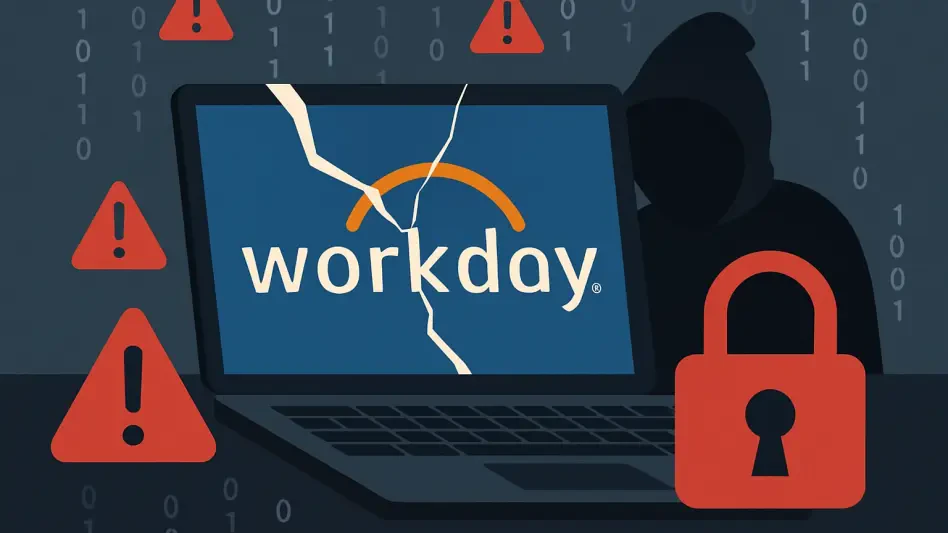In a stark reminder of the vulnerabilities lurking within interconnected enterprise systems, a recent data breach at Workday, a prominent provider of cloud-based solutions for finance and human resources, has brought the dangers of third-party applications into sharp focus. This incident, stemming from a compromised integration with a third-party tool, revealed how even robust security measures can be undermined by weaker links in the supply chain. The breach not only exposed sensitive customer data but also affected several high-profile organizations, amplifying concerns about the security of vendor ecosystems. As cyber threats continue to evolve, this event underscores the urgent need for companies to reassess their reliance on external applications and prioritize stringent vendor oversight. The implications of such breaches extend far beyond immediate data loss, eroding trust and highlighting systemic risks in modern business environments.
Unpacking the Breach: How It Happened
The origins of this cybersecurity incident trace back to a third-party application, specifically Salesloft’s Drift tool, which was integrated into Salesforce environments used by Workday. Threat actors exploited this connection by compromising infrastructure and gaining access to OAuth credentials, enabling unauthorized searches within affected systems. This breach exemplifies a supply chain attack, a tactic where attackers target less secure external vendors to infiltrate larger, better-protected organizations. The incident exposed a range of data, including business contact information and support case details, though core systems remained untouched. Such attacks are becoming increasingly common as cybercriminals seek out vulnerabilities in interconnected networks, bypassing traditional defenses by exploiting trusted relationships. This case serves as a critical example of how even limited access through a third party can have far-reaching consequences for enterprise security.
Further details of the breach reveal the sophisticated methods employed by attackers to exploit third-party integrations. By targeting a widely used application like Drift, the perpetrators gained a foothold in multiple organizations’ environments, highlighting the cascading risks of shared tools. The compromised data, while not including highly sensitive files like contracts, still posed significant risks to affected companies through potential misuse of business information. Workday’s instance of Salesforce was among those infiltrated, demonstrating that even industry leaders are not immune to such threats. The breach emphasizes the importance of scrutinizing every link in the digital supply chain, as a single point of failure can jeopardize entire ecosystems. As cyber threats grow in complexity, understanding the mechanics of such incidents is vital for developing effective countermeasures and preventing similar occurrences in the future.
Impact on High-Profile Organizations
The ripple effects of this breach extended to numerous well-known companies across various sectors, showcasing the interconnected nature of modern enterprise systems. Organizations such as Palo Alto Networks, Google, and Cloudflare were among those affected, with exposed data ranging from internal sales information to limited customer account details. While the scope of compromised information varied, the incident revealed how a single vulnerability in a third-party tool can impact a diverse array of businesses. This widespread reach underscores the systemic risk posed by shared applications, where a breach in one environment can quickly spread to others. The incident has sparked renewed discussions about the need for comprehensive risk assessments across vendor networks to prevent such broad exposure.
Beyond the immediate data exposure, the breach has raised significant concerns about trust and operational integrity among the affected organizations. For instance, while some companies reported only minimal access to non-critical information, the potential for reputational damage remains high as customers question the security of their data. The diversity of impacted entities, spanning technology, security, and cloud services, illustrates the pervasive nature of supply chain vulnerabilities. This event serves as a wake-up call for industries reliant on third-party integrations, prompting a reevaluation of how data is shared and protected within collaborative platforms. Addressing these challenges requires a collective effort to establish stricter security standards and ensure that even peripheral systems are fortified against emerging threats.
Workday’s Response and Mitigation Efforts
Upon discovering the unauthorized access, Workday acted swiftly to contain the breach and minimize further risk. The company disconnected the compromised third-party application, invalidated access tokens, and engaged an external forensics firm to conduct a thorough investigation. Findings confirmed that the breach was confined to a small subset of data within its Salesforce environment, sparing sensitive external files and core customer systems. This prompt response helped to limit the damage, but it also highlighted the critical need for rapid detection and containment strategies in the face of supply chain attacks. Workday’s actions reflect a commitment to transparency and accountability, setting an example for how enterprises should handle such incidents.
In addition to immediate containment measures, Workday took proactive steps to support affected customers and prevent future breaches. Recommendations included rotating credentials that may have been shared in support cases, adopting multi-factor authentication, and enhancing phishing awareness training. The company also urged vigilance in monitoring for suspicious activity and began a comprehensive review of all vendors using the implicated application. These measures aim to strengthen defenses not only within Workday’s ecosystem but also among its clients who rely on integrated tools. By sharing actionable guidance, Workday emphasized the shared responsibility of securing digital environments, encouraging a culture of proactive cybersecurity that extends beyond individual organizations to encompass entire supply chains.
Broader Implications for Enterprise Security
This incident sheds light on a growing trend in cybersecurity: the increasing sophistication of supply chain attacks targeting third-party integrations. As attackers exploit weaker links in vendor ecosystems to bypass stronger defenses, enterprises must prioritize rigorous vendor risk assessments and enforce stringent security protocols. The breach demonstrates that even limited data exposure can have significant repercussions, affecting customer trust and operational continuity. It also highlights the need for continuous monitoring and updating of security practices to keep pace with evolving threats. The cybersecurity community agrees that such incidents are likely to become more frequent, making it imperative for companies to adopt a holistic approach to protecting their digital assets.
Looking deeper, the event calls attention to the structural vulnerabilities inherent in interconnected enterprise systems. Relying on third-party applications, while essential for efficiency and scalability, introduces risks that must be meticulously managed. Organizations are now compelled to rethink their dependency on external tools and invest in robust frameworks for evaluating and securing vendor relationships. Collaboration between companies, vendors, and cybersecurity experts is crucial to developing standardized practices that can mitigate these risks. As the digital landscape continues to expand, fostering resilience against supply chain attacks will require innovation, vigilance, and a commitment to shared security goals across industries.
Strengthening Defenses: Lessons Learned
Reflecting on the breach, it became evident that safeguarding enterprise environments demanded a reevaluation of third-party relationships. Workday’s immediate disconnection of the compromised application and thorough investigation set a precedent for rapid response, while their guidance on credential rotation and enhanced authentication offered practical steps for prevention. The incident, which impacted a range of prominent companies, exposed the fragility of interconnected systems, yet it also spurred action to fortify defenses. Moving forward, businesses were encouraged to integrate continuous vendor audits and adopt advanced threat detection mechanisms to anticipate and neutralize risks. By learning from this event, the industry took strides toward building a more secure digital ecosystem, ensuring that past vulnerabilities paved the way for stronger, more resilient protections.








